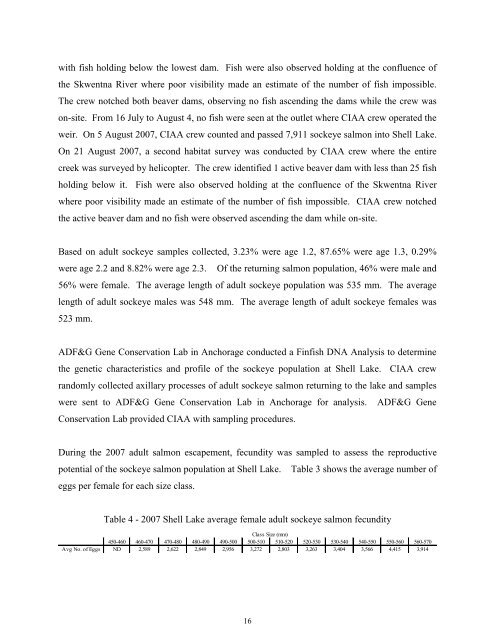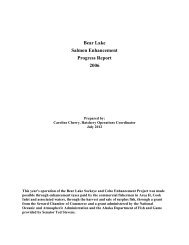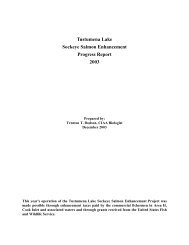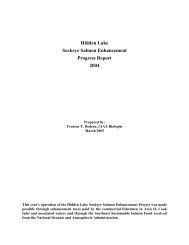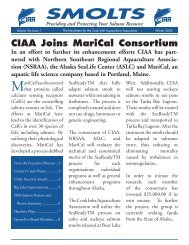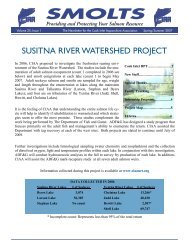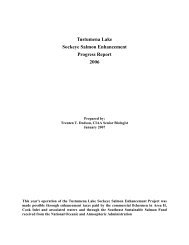Chenik Lake - Cook Inlet Aquaculture Association, Kenai, Alaska
Chenik Lake - Cook Inlet Aquaculture Association, Kenai, Alaska
Chenik Lake - Cook Inlet Aquaculture Association, Kenai, Alaska
Create successful ePaper yourself
Turn your PDF publications into a flip-book with our unique Google optimized e-Paper software.
with fish holding below the lowest dam. Fish were also observed holding at the confluence of<br />
the Skwentna River where poor visibility made an estimate of the number of fish impossible.<br />
The crew notched both beaver dams, observing no fish ascending the dams while the crew was<br />
on-site. From 16 July to August 4, no fish were seen at the outlet where CIAA crew operated the<br />
weir. On 5 August 2007, CIAA crew counted and passed 7,911 sockeye salmon into Shell <strong>Lake</strong>.<br />
On 21 August 2007, a second habitat survey was conducted by CIAA crew where the entire<br />
creek was surveyed by helicopter. The crew identified 1 active beaver dam with less than 25 fish<br />
holding below it. Fish were also observed holding at the confluence of the Skwentna River<br />
where poor visibility made an estimate of the number of fish impossible. CIAA crew notched<br />
the active beaver dam and no fish were observed ascending the dam while on-site.<br />
Based on adult sockeye samples collected, 3.23% were age 1.2, 87.65% were age 1.3, 0.29%<br />
were age 2.2 and 8.82% were age 2.3. Of the returning salmon population, 46% were male and<br />
56% were female. The average length of adult sockeye population was 535 mm. The average<br />
length of adult sockeye males was 548 mm. The average length of adult sockeye females was<br />
523 mm.<br />
ADF&G Gene Conservation Lab in Anchorage conducted a Finfish DNA Analysis to determine<br />
the genetic characteristics and profile of the sockeye population at Shell <strong>Lake</strong>. CIAA crew<br />
randomly collected axillary processes of adult sockeye salmon returning to the lake and samples<br />
were sent to ADF&G Gene Conservation Lab in Anchorage for analysis. ADF&G Gene<br />
Conservation Lab provided CIAA with sampling procedures.<br />
During the 2007 adult salmon escapement, fecundity was sampled to assess the reproductive<br />
potential of the sockeye salmon population at Shell <strong>Lake</strong>. Table 3 shows the average number of<br />
eggs per female for each size class.<br />
Table 4 - 2007 Shell <strong>Lake</strong> average female adult sockeye salmon fecundity<br />
Class Size (mm)<br />
450-460 460-470 470-480 480-490 490-500 500-510 510-520 520-530 530-540 540-550 550-560 560-570<br />
Avg No. of Eggs ND 2,589 2,622 2,849 2,956 3,272 2,803 3,263 3,404 3,566 4,415 3,914<br />
16


